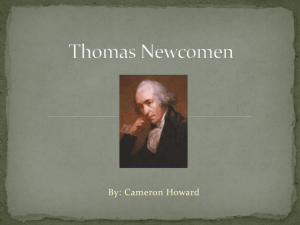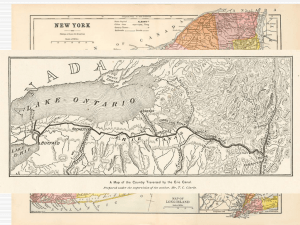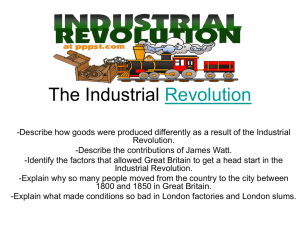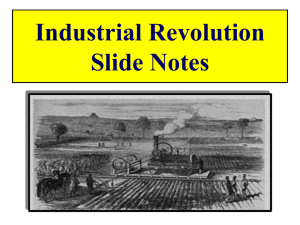Steam Engine
advertisement
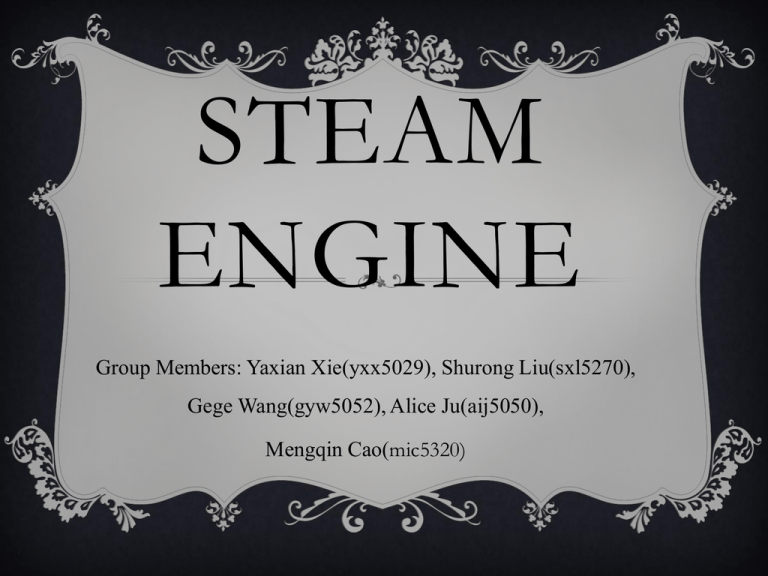
STEAM ENGINE Group Members: Yaxian Xie(yxx5029), Shurong Liu(sxl5270), Gege Wang(gyw5052), Alice Ju(aij5050), Mengqin Cao(mic5320) If you want to know who invented the first steam engine, you would have to go back in time almost 2000 years. The idea of heating water to produce steam, then using that steam to move something, was thought about by Hero in the first century. Steam Engine An engine that converts the heat energy of pressurized steam into mechanical energy, especially one in which steam drives a piston in a closed cylinder. http://www.answers.com/topic/steamengine#ixzz1CvviVWAG Thomas Savery who invented the first workable, although crude, steam engine. Thomas Savery was an English engineer and inventor. HISTORY OF INVENTION • Thomas Savery patented • Thomas Newcomen • Watt's engine was the dominant design for all improved on this the first crude steam engine design modern steam engines in 1698. Thomas Savery (1650-1715) Thomas Savery patented the first crude steam engine based on pressure cooker of 1679. He solved the problem of pumping water out of coal mines. Thomas Newcomen (16631729) Thomas Newcomen invented the atmospheric steam engine, an improvement over Thomas Slavery's previous design. The Newcomen engine was the predecessor to the Watt. James Watt (1736-1819) James Watt improved on the steam engine in the second half of the 18th century that it became a truly viable piece of machinery that helped start the Industrial Revolution. WHAT PEOPLE’S LIFE WAS LIKE BEFORE THE INVENTION OF THE STEAM ENGINE? • Without a doubt, the invention of the steam engine has changed people life in my aspects. This great invention is a milestone of the development of the human civilization. • The invention of the steam engine solved the energy crisis at that time of period. One of the greatest contribution of the steam engine is that it turns coal into a everyday energy for people to use. W H AT P E O P L E ’ S L I F E WA S LIKE BEFORE THE INVENTION OF THE STEAM ENGINE? • The invention of the steam engine is also a saver for the factory. Before the factory started to use steam engine, the workers have to work for more than 14 hours a day. The invention of the steam engine increased the efficiency of work. THE DISADVANTAGE OF THE STEAM ENGINE • The invention of the steam engine was known as a “invention that changes the whole century”, it plays a great role in human development. However, the steam engine is also like a “Pandora box”, we can also find the negative impact of the steam engine. THE DISADVANTAGE OF THE STEAM ENGINE • First of all, the steam engine brought huge pollution to the environment. Since people started to use the steam engine, they kept pillage the natural resources like coal, petroleum, natural gas, metal mineral resource, etc. • What’s more, the Home trash, electronic trash, industrial refuse, industrial waste that people produce because of the product of the steam engine is also a huge harming to the environment. HOW IT WORKS… MAIN COMPONENTS There are four main different parts in a steam engine: A fire where the coal burns. A boiler full of water that the fire heats up to make steam. A cylinder and piston, rather like a bicycle pump but much bigger. Steam from the boiler is piped into the cylinder, causing the piston to move first one way then the other. This in and out movement (which is also known as "reciprocating") is used to drive... A machine attached to the piston. That could be anything from a water pump to a factory machine... or even a giant steam locomotive running up and down a railroad. That's a very simplified description, of course. In reality, there are hundreds or perhaps even thousands of parts in even the smallest locomotive. Coal is loaded into the firebox (1), which is a metal box containing a coal fire. This fire then heats up the boiler or the “giant kettle” inside the locomotive. The boiler (2) is big tank of water with dozens of thin metal tubes, or boiler tubes, that run from the firebox to the chimney (7), carrying the heat and the smoke of the fire with them. This arrangement of tubes means the engine’s fire can heat the water in the boiler tank much faster, so it produces steam more quick and efficiently. The water that produces this steam comes from tanks on the side of the locomotive or from a separate wagon called a tender, pulled behind the locomotive. The steam generated in the boiler flows into a cylinder (3), pushing the piston (4) back and forth. As the piston pushes, the crank and connecting rod (5) turn the locomotive’s wheels and power the train along (6). http://www.explainthatstuff.com/steamanimation.html (The graph is on the next page.) Thermodynamics is the science of energy conversion involving heat and other forms of energy, most notably mechanical work. Historically, thermodynamics developed out of a desire to increase the efficiency of early steam engines, particularly through the work of French physicist Nicolas Léonard Sadi Carnot (1824) who believed that engine efficiency was the key that could help France win the Napoleonic Wars. The steam engine is a heat engine converting heat energy to work. Heat is transferred to water in the boiler. The steam carries energy to the engine where part of the heat energy is converted to mechanical energy, work. The steam leaves the expander and is condensed back to water rejecting some heat energy. This is known as an external combustion engine. These processes must conform to the First Law of Thermodynamics. This cycle is called the Rankine cycle. CONCLUSION ADVANTAGE The strength of the steam engine for modern purposes is in its ability to convert heat from almost any source Into mechanical work. It is safe and efficient. HISTORICAL INFLUENCE The introduction of steam power fuelled primarily by coal, wider utilisation of water wheels and powered machinery (mainly in textile manufacturing) underpinned the dramatic increases in production capacity. It was the beginning of the First Industrial Revolution which marked a major turning point in human history; almost every aspect of daily life was influenced in some way, such as transport and manufacturing.

